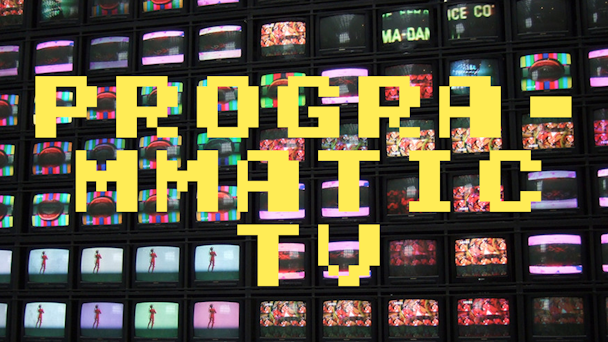Get ready for programmatic TV advertising
One day, in the not too distant future, all TV ads will be bought programmatically. Linear TV ad inventory will be available on the open exchange, targeted to the individual, and highly measurable in its performance. This would be truly programmatic TV, and it can’t come soon enough.

In the meantime, advertisers have a slightly perplexing list of options, which can basically be categorised as the below five:
1. Traditional (manual, upfront);
2. Data-driven traditional (Open AP is a good example);
3. Programmatic direct (automated, upfront);
4. Programmatic for OTT (automated, internet TV);
5. Programmatic for VOD (automated, digital form of broadcast TV).
The main competitors
Someone is going to crack this perfect blend of digital and traditional. It’s just a question of who.
Open AP (Turner, Viacom, Fox)
So this one’s not programmatic at all, but it’s a sign of change in the US TV industry. In an effort to improve targeting, Turner, Viacom and Fox joined forces this year to form Open AP, a centralised digital user interface that enables data-sharing, improves data transparency, and enhances targeting.
Media inventory still needs to be purchased manually, and the performance of a campaign cannot be monitored. However, this does offer a more data-driven approach and may be a stepping stone towards programmatic TV.
Sky AdSmart
Sky launched AdSmart about three years ago, allowing advertisers to purchase spots in real time via their app, Sky Go, and to overlay first-party data with Sky’s own audience segments and a number of audiences from third-party data providers.
As the broadcaster announced earlier this year, the ultimate plan is to make all of their TV inventory available programmatically. Even live TV will ostensibly be accessible via real time bidding, with highly granular targeting, and the opportunity to measure performance via their own DMP.
UK broadcasters
Channel 4, Channel 5 and most recently ITV are developing ad tech to enable addressable TV advertising, i.e. ads which are targeted to households, and can be bought in real time rather than upfront.
OTT/ Internet TV providers
They’ve certainly started on the right track, being conceived during the digital era. And, unlike traditional broadcasters, they have the great advantage of the box, i.e. all their customers have a nice piece of connected hardware they can use to obtain data, identify individual users, monitor, analyse etc etc. Sling TV has made promising progress in this area.
Google, Amazon and Facebook
Google added TV inventory to DBM last month. DoubleClick is a well-developed platform for enabling targeting and monitoring, so there’s no doubting its capability there. The question, however, is whether they’ll successfully get the co-operation of broadcasters. Time will tell, but until they do this isn’t really an option at the moment.
Amazon’s newly launched pay-TV service, Amazon Channels, is a slightly different approach. Instead of offering advertisers a programmatic route into traditional broadcaster platforms, their approach is to bring live TV to their own platform. Once again, they certainly have the data to provide targeting and monitoring, but the compliance of broadcasters is dubious. ITV have, however, agreed to run their ITV Hub catch-up service via Amazon’s platform.
Facebook’s plan is to sell broadcasters their ad tech and data to enable programmatic TV buying, but so far only on OTT devices or through VOD apps. Still, there’s no reason why this approach might not also be applied to linear TV, if and when broadcasters stop resisting.
Why programmatic TV is the best future
The problem with the past, in terms of TV advertising, was its general inaccessibility to smaller businesses. The rise of digital - AdWords, programmatic display, YouTube, Facebook - has opened up the industry to a far greater range of advertisers, which is good for the industry and for the economy in general.
TV is next. Though only predicted to make up a modest 8% of all UK TV ad spend next year (2018), if live TV were to become available programmatically (truly programmatic, not the lame ‘programmatic direct’) then we could expect this figure to be more like 80%.
For now, broadcasters will stubbornly (though understandably) preserve live TV inventory as the most expensive advertising medium. They can’t do this forever, though, and the cracks are already starting to appear.
As a report from the Advertising Association recently revealed, internet ad spend is expected to rise 8.5 per cent during 2017, while TV is forecast to fall 0.5 per cent. The unilateral move towards programmatic TV reflects traditional broadcasters’ awareness of the threat of digital, and the need to do something to compete with the efficiency of automation.
As the tide turns, TV ad inventory will become part of a market that is far closer to a perfect competition model than the past. Inventory will still be purchased and sold according to the highest bid, true, but without bias on account of the seller or the buyer, and the main barrier of entry for traditional TV (extortionate prices) will be greatly lowered by the efficient marketplace of programmatic.
Whoever emerges the victor of this tech arms race, the industry itself will benefit from a more complete integration of digital and TV.
Within the next three years (imo), we can expect to see TV obtain the supremely data-driven status of digital. Marketers from businesses of all sizes, if they haven’t already, should be adjusting their strategy accordingly.
Dan Gilbert is founder and chief executive officer of Brainlabs
Content by The Drum Network member:

Brainlabs
Brainlabs was founded in 2012 by former Googler Daniel Gilbert. After training some of the UK's top agencies, he realised they weren't very good. They lacked the...
Find out more